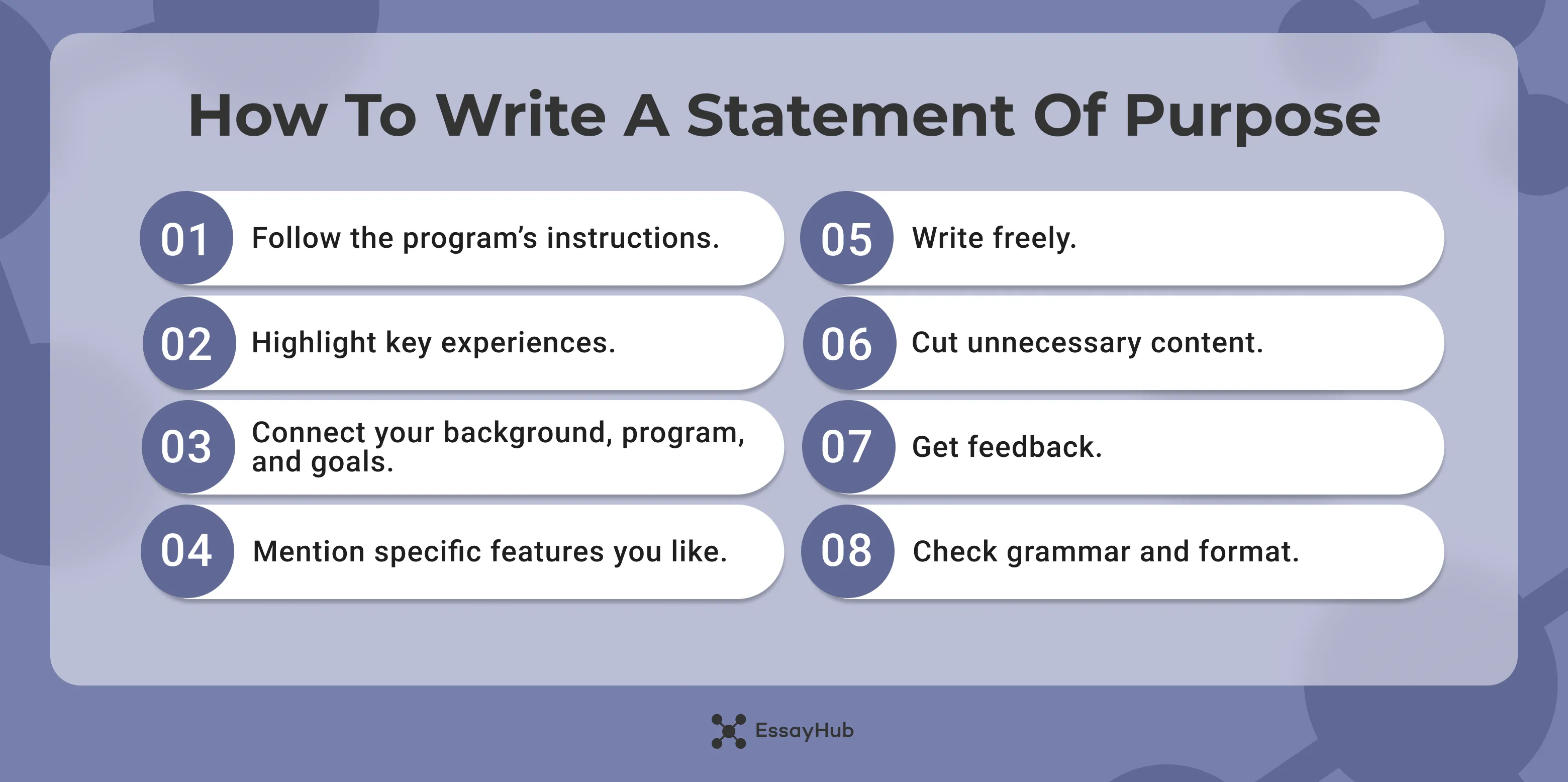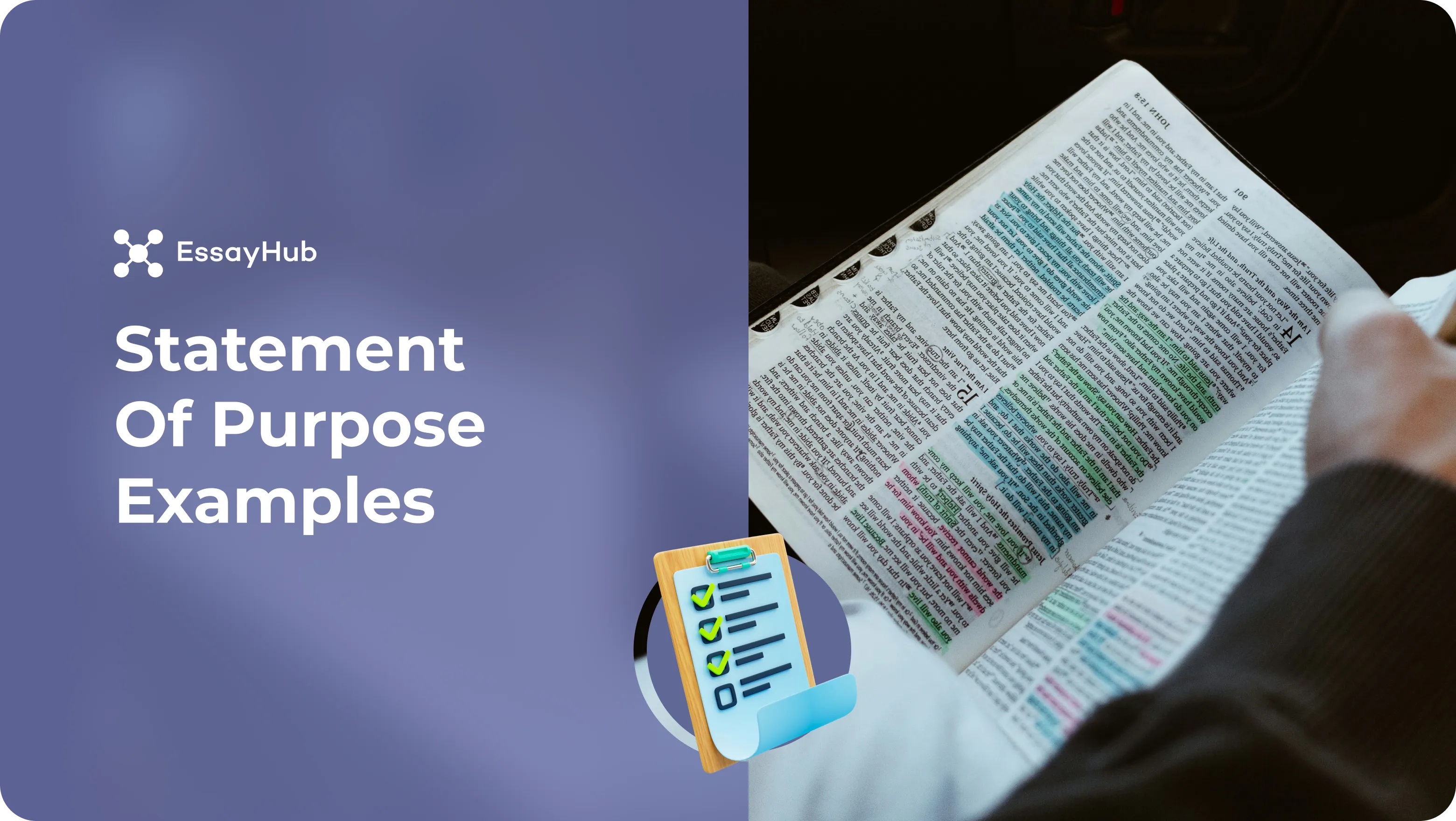Grad school applications seem to be nothing but a list of forms and numbers. You upload transcripts and hunt down recommendation letters, and then, you reach the statement of purpose. The mood shifts. This is the one piece that feels alive. Admissions committees pay close attention to it because it's your voice on the page.
It's always better to look at a real statement of purpose example. You're about to see eight samples and what makes them work (or not). If creating one of your own still feels overwhelming after this article, you can always ask an academic ghost writer from EssayHub to give you an extra hand.
What Is a Statement of Purpose?
A statement of purpose is a personal essay describing the reasons why you're applying for a specific program. A strong piece also convinces the admissions committee of why they should want to accept you. You're given a chance to connect your background with your future and also show who you are beyond your test scores.
How Long Should a Statement of Purpose Be?
There’s no magic number, but most schools expect something in the 500 to 1,000-word range. Some programs are strict about word limits, so read their instructions carefully. The best statements cover everything they need to without wasting a single line. Clear, direct, and personal - that’s the sweet spot.
How to Write a Statement of Purpose?
You already know that a statement of purpose must be smart and memorable, yet the words don't seem to come. When you write a statement of purpose, it's best to break the process down into more manageable chunks. Looking through personal essay ideas can help you shape a story that proves you belong in that program. Here's how you can pull it off.

Step 1: Understand What They Want
Every grad school has its own expectations. Some want you to focus on academic achievements, others care more about your career goals. Read the instructions carefully. Then read them again. Save yourself from writing a beautiful essay that misses the mark simply because you didn't know what was asked.
Step 2: Reflect on Past Experiences
Consider what formed you. Classes that interested you. Projects that kept you up all night. Work experience or internships that led you in this direction. Recall moments that actually meant something to you because those are the ones that are going to sound genuine.
Step 3: Connect Past and Future
Now take those moments and connect them to what you're seeking in the future. Show a clear path to this program from your background, and from the program to your future. It's like placing stepping stones where each one leads to the next.
Step 4: Highlight the Program Fit
Admissions committees want to see that you're familiar with this particular program, not just any. Mention specific research opportunities and any unique characteristics that drew your attention. Be truthful. The admissions committee can always tell when you're throwing in names to impress them.
Step 5: Write the First Draft
Allow the words to flow. Do not seek out perfect sentences just yet. Simply get your ideas out: talk about why you are interested and why this grad school is important to you. You can edit everything later.
Step 6: Edit and Polish
Start cutting everything that feels flat once you have a draft in hand. To-the-point writing always hits harder. Unless each paragraph adds something new to the statement, it won't keep the reader moving forward, meaning it must be tweaked.
Step 7: Get Feedback and Revise
If you have someone in your close circle who knows academic writing, show your draft to them. A second set of eyes will always catch what you might have missed. Take their advice and polish the text, but don't drift off so it stops sounding like you.
Step 8: Check the Details
Proofread until your eyes ache. Grammar slips and typos can break the flow for the reader. Also, confirm that you followed every single guideline the program gave you. No missed word counts, no formatting errors.
Statement of Purpose Examples
It's just easier sometimes to follow someone else's example to make your writing flow better. We'll give you 8 statement of purpose examples so you can see how the parts play out in action.
Graduate School
Following a few simple rules is what makes this statement effective. It moves naturally through a story of experiences and future goals. This statement of purpose for graduate school also uses specific examples that show genuine motivation from the applicant's side. The personal yet professional tone allows them to express their readiness for graduate school.
Each section of this statement carries at least some weight. The writer walks you through the thought process behind their choices. It feels honest. No sentence overstays its welcome. You can hear the moments of uncertainty and the clear pull toward this field. Specific details, not vague statements, do the heavy lifting. By the end, you trust the person behind the words. That’s what makes this one work.
Scholarship
This one speaks plainly, but the message lands. Nothing feels forced. The experiences are specific, and they’re connected without being spelled out. You feel the effort and the small wins that build into something bigger. Details come in naturally, but none of it reads like a checklist. There’s rhythm. Some sentences stretch out, others land short. It sounds like someone thinking as they write, someone who’s lived what they’re describing.
This statement starts with a vivid memory and lets that moment guide the rest. The writing moves between past and present, tying experiences to goals without overexplaining everything. Real details do most of the work. The tone stays grounded, even when the ambitions are big. It’s not trying to impress. It’s just trying to be understood. That honesty holds it together.
Masters Degree
The writing starts with one memory and lets it grow into a purpose. It doesn’t rush. There’s space between ideas, like someone thinking out loud and meaning it. Details don’t feel borrowed; they feel lived. Nothing is overstated. The voice stays personal and clear, which is exactly what you want when someone is trusting you with their future plans.
This statement of purpose for masters follows a clear structure. It opens with a personal moment that creates curiosity, then flows into academic background and long-term goals. The language stays conversational but focused - never too formal or too casual. The writer names specific interests in the program, which shows genuine alignment. It works because it reads like someone who knows where they’re going and is prepared to learn along the way.
Internship
This statement opens with a lived moment, not a polished pitch. Each section moves the story forward. Experiences feel specific and earned. The voice sounds like someone working things out as they write, which makes the whole thing feel honest and grounded.
It begins with a real story, although it is unusual. Each paragraph ties experience with reflection in a steady tone. The rhythm shifts, on the other hand: some sentences stretch a bit, others hit quickly. You can almost feel the applicant thinking as they write. Honest without being heavy. That balance makes it believable.
If you want to go beyond your goals and accomplishments and write about who you are, check out our article on personal statement examples so you know exactly how one is written.
Closing Thoughts
Every strong statement of purpose starts with something real. Doesn't matter if you're applying for grad school or a Master's program; you need to show purpose and intention every time. The examples in this article will show you how to write one in a way that's rooted in something real, not a piece that feels like a checklist.
If you're working on your own draft, EssayHub can always step in and help. Our team exists for students unsure how to start their writing. Sometimes, all it takes is a little professional help to turn your ideas into structured pieces that sound like you.
FAQ
How Can I Make a Statement of Purpose Stand Out?
Don’t write what you think they want to hear. Tell the truth, the version that only you can tell. Use specific details to make your writing grounded in real life. Use your own voice, even if it sounds messy at first. That’s what will make your statement of purpose stand out.
How Do You Write a Statement of Purpose Example?
You write it like you mean it. You don’t rush. You dig around until you find the parts that brought you where you are now. Then you lay them out so they make sense without feeling forced. Some parts will come easily, others will take longer. That’s fine. Let the voice sound like a person thinking. That’s the kind of writing people remember.
How Do You Start a Statement of Purpose Example?
You start small with a single moment that has stuck with you. Maybe it was a question you couldn't stop thinking about or the moment something you were struggling with suddenly clicked. Skip the big declarations here and simply begin with something true. That's how you pull the reader in.
- Writing Your Statements - Berkeley Graduate Division. (2025, June 13). Berkeley Graduate Division. https://grad.berkeley.edu/admissions/application-process/writing-your-statements/
- Writing a Statement of Purpose. (2023, June 28). https://www.csulb.edu/graduate-center/writing-a-statement-of-purpose
- Graduate School Statement of Purpose : EECS Communication Lab. (2015). mit.edu. https://mitcommlab.mit.edu/eecs/commkit/graduate-school-statement-of-purpose/




